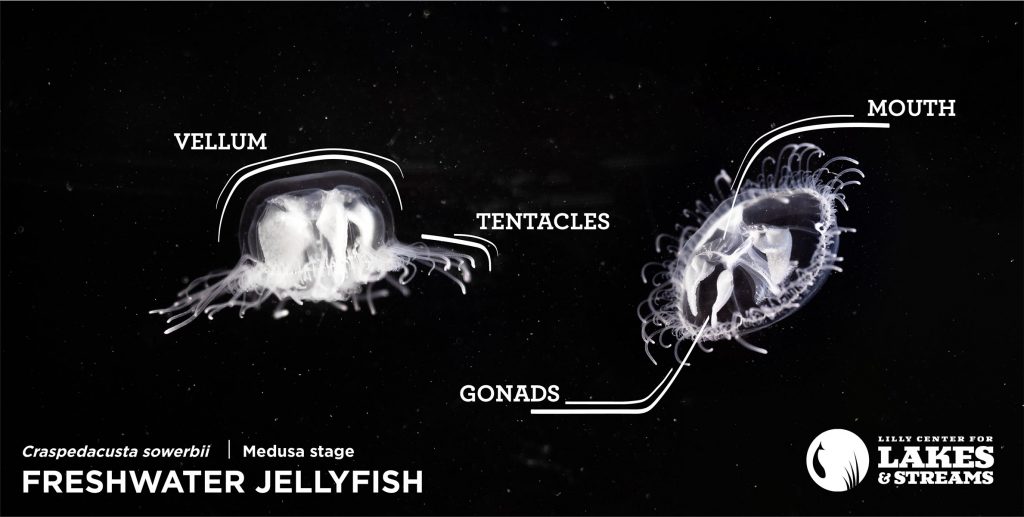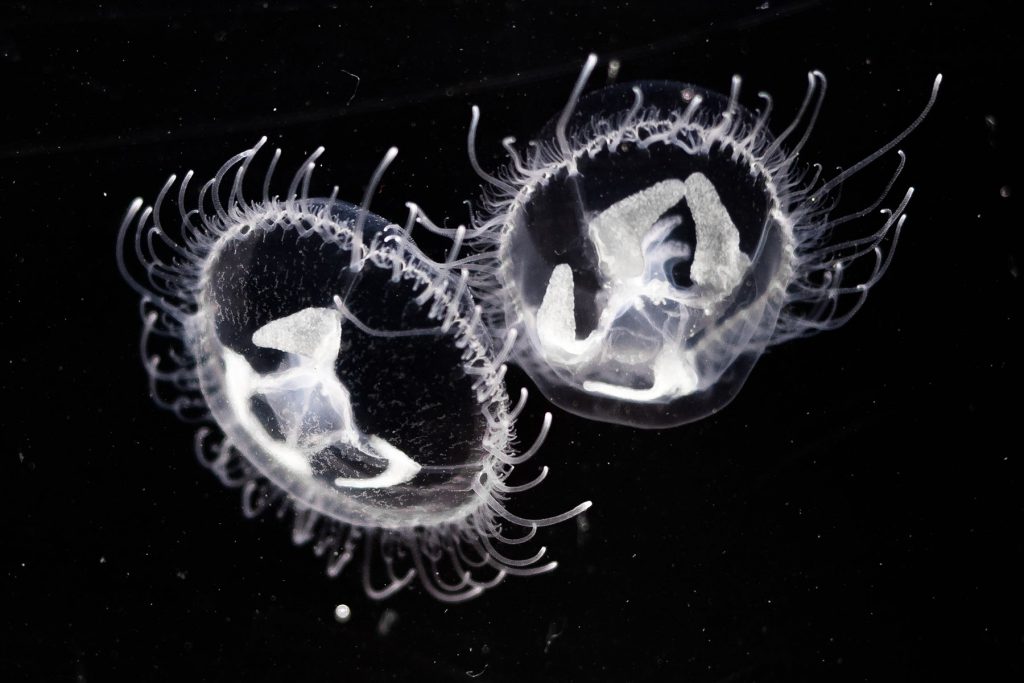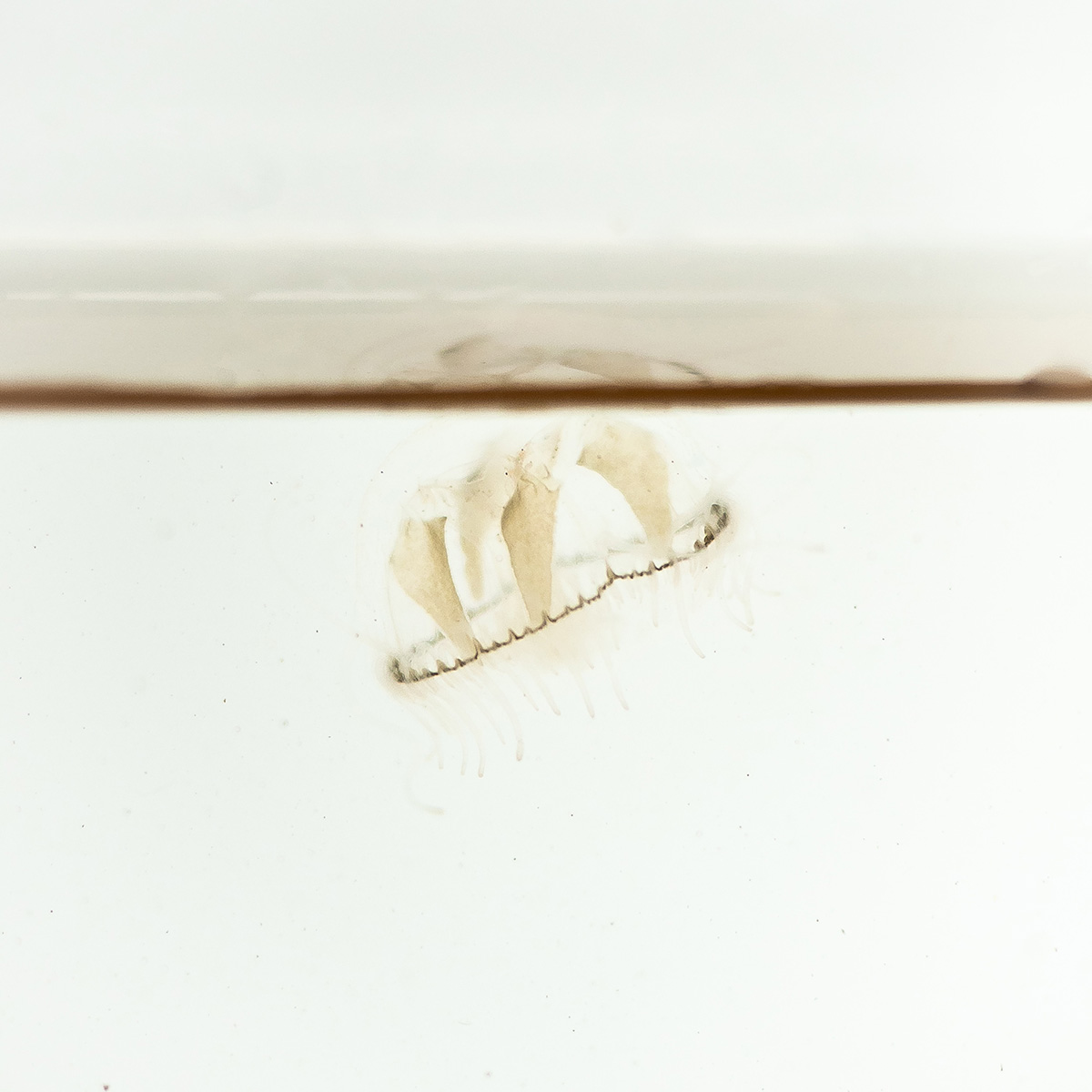Toast and Jellyfish – the Tea on Freshwater Jellies
You are probably familiar with the different creatures found in Indiana’s ponds and lakes, but you might not include jellyfish in that list. While it sounds like a myth, freshwater jellyfish do live in Indiana, though only the luckiest of lake lovers have laid eyes on them. Thanks to a Lilly Center friend who found freshwater jellyfish in his pond, we were able to study some of these penny-sized creatures. Let us dive deeper into the underwater wonder that is freshwater jellyfish, as we’ve done with diatoms and volvox previously.
Of jellyfish biology
Craspedacusta sowerbii is a small, white, and mostly-transparent jellyfish that lives exclusively in calm bodies of fresh water like ponds, lakes, old quarries, and slow-moving streams. They are very small – they grow no larger than an inch in diameter and never more than 0.3 grams in body weight. They have a radial (circular) body layout and the tentacles form a ring around the base of the body. They consume and excrete food from the mouth on the underside. Inside, four gonads are clearly visible.

C. sowerbii is not a ‘true jellyfish’. It is a hydrozoan jellyfish that is more closely related to the Portuguese man-o’-war or the native hydra than it is to the scyphozoan jellyfish (the ‘true jellyfish’). Freshwater jellyfish have a muscular membrane on their body that sets them apart from true jellyfish. This membrane is called the velum which they use to move (imagine using your diaphragm for propulsion).
Can freshwater jellyfish sting?
No, C. sowerbii cannot sting humans. They do have stinging cells (called nematocysts) but they are too small to sting through our skin. They are small so that they can capture microscopic prey such as daphnia and other zooplankton. And, according to some scientists, their small stingers don’t prevent them from becoming a meal for animals higher up the food chain. It is said that crayfish enjoy jellyfish, presumably with biscuits or English muffins.
Why is it so hard to find freshwater jellyfish in Indiana?
Freshwater jellyfish seem to appear at random in different bodies of water, but rarely in the same place for multiple years in a row. This is because of C. sowerbii’s elaborate life cycle. The jellyfish stage, also called the medusa stage, is the final step of that cycle. The main goal of the medusa form is to reproduce sexually, though this form only lives for a few months at most. For most of a jellyfish’s life (sometimes up to fifteen or more years), it rests attached to the lakebed in a coral-like ‘polyp’ form. These polyps reproduce asexually by budding, creating a small army of clones that are genetically identical to the original polyp. When the conditions are right those polyps transform into the free-swimming medusa.

What conditions lead to the formation of a ‘smack’ (the real name for a group of jellyfish)? Scientists are not entirely sure, though temperature seems to play a large role in the process.
The duplication ability means that it only takes one freshwater jellyfish to create a population. A single organism can multiply hundreds or thousands of times. The resulting swarm has one distinct problem: since they all have the same genetic ‘identity’ (and thus are the same sex), they can only reproduce by budding. As a result, freshwater jellyfish tend to only appear in medusa form every five to fifteen years.
Are freshwater jellyfish native?
C. sowerbii is originally from the Yangtze River region of China, though it has spread to every continent except for Antarctica. It is believed that it was first transported accidentally to the United States inside shipments of aquatic ornamental plants. As previously mentioned, it only takes one individual to make a colony. They spread through a variety of methods including the aquarium trade, fish stocking, boating and even clinging to the feathers of waterfowl, creating colonies wherever they end up.
This does not necessarily mean that freshwater jellyfish are a harmful invasive species. It is unknown exactly what impact they have on ecosystems once introduced and if that impact is detrimental or not. Unlike zebra mussels or starry stonewort, freshwater jellyfish do not destroy habitats or crowd out other species; they simply exist alongside other native creatures. Some scientists call non-native species like C. sowerbii ‘exotic’ instead of ‘invasive’ to make a distinction between species that do not cause harm to local ecosystems from those that do.

What now?
We will follow up on this topic as more is discovered about freshwater jellyfish. If you are lucky enough to come across a smack of jellies, may you appreciate the amazing and complicated beauty of these radial rarities.